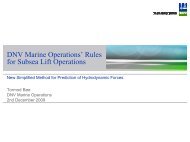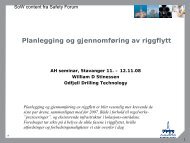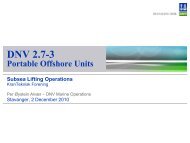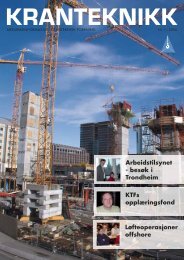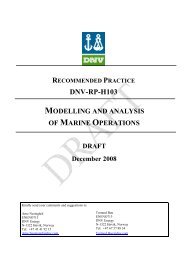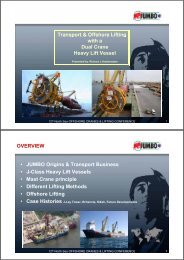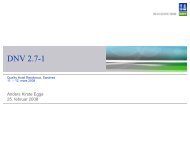Analysis of subsea lifting operations Introduction
Analysis of subsea lifting operations Introduction
Analysis of subsea lifting operations Introduction
Create successful ePaper yourself
Turn your PDF publications into a flip-book with our unique Google optimized e-Paper software.
Subsea <strong>lifting</strong> <strong>operations</strong>Stavanger - Nov. 29-30 2011<strong>Analysis</strong> <strong>of</strong> <strong>subsea</strong> <strong>lifting</strong><strong>operations</strong>Peter Chr. SandvikMARINTEKMARINTEK 1
<strong>Analysis</strong> <strong>of</strong> <strong>subsea</strong> <strong>lifting</strong> <strong>operations</strong><strong>Introduction</strong>• DNV RP-H103 gives recommendations on:• Method(s) for simplified quasi-static analysis• Hydrodynamic data for simple objects• More advanced modelling and analysis• This presentation will focus on modelling and dynamicanalysisMARINTEK2
Good reasons for doing accurate simulations:• Confident estimates <strong>of</strong> extreme forces to be expected• Support for development <strong>of</strong> plans and procedures• Good basis for defining limiting environmental conditions• Good understanding <strong>of</strong> dynamic behaviour• Identification <strong>of</strong> 'strange' effects and critical stages• Input to adjustment <strong>of</strong> method and equipment• 3D animations useful / vital for HAZID / Safe Job <strong>Analysis</strong>MARINTEK 3
<strong>Analysis</strong> <strong>of</strong> <strong>subsea</strong> <strong>lifting</strong> <strong>operations</strong>Different systems or situationsSimpleStationary conditions• No system changes• Small changes in geometry• Unchanged hydrodynamic forcemechanismsComplexChanges during the operation:• Impacts, slack/snatch• S<strong>of</strong>t impacts• Lift-<strong>of</strong>f• Varying geometry• Water entry / exit• Soil forces at landingLinear methodsFrequency domain analysisNon-linear methodsTime domain simulationMARINTEK4
Wave forces in the splash zoneExample: Template1 2 34 5 6Large dynamic forces (± 140 T)MARINTEK 6
<strong>Analysis</strong> <strong>of</strong> <strong>subsea</strong> <strong>lifting</strong> <strong>operations</strong>Structure sizeSimple• Small horizontal dimensionscompared to wave length• Small vertical dimensions• Structure does not influence onvessel motionComplex• Wave forces vary over thestructure (L > λ / 4)• Wave forces vary with depth• Dynamic forces from thestructure may influence rollmotion• Changing hook load will changethe ship's heel angleObject considered as a pointVessel's motion RAOs can be usedDistributed hydrodynamic forcesSimultaneous solving <strong>of</strong> allequations <strong>of</strong> motionMARINTEK7
F / F0, M / F0 LHeave force and pitch moment on a long member(It is conservative to assume small body, concentrated loads)Wave force on an element dx:Maximum total wave force:FF0f A( 1 ca ) dx L sin L F0 AL 1 ca)2 wavelength2( 010.8ForceMoment0.60.4Harmonic wave:amplitude ζfrequency 0.200 0.5 1 1.5 2 2.5 3L / WavelengthMARINTEK 8
Z (m)Wave kinematicsReduction with depthRekze 4z2 TReduction <strong>of</strong> wave kinematics with depth0-10-20-30-40-50-60-70T = 4sT = 6sT = 10sT = 14sT = 20s-80-90-1000 0.2 0.4 0.6 0.8 1Depth reductionMARINTEK 9
<strong>Analysis</strong> <strong>of</strong> <strong>subsea</strong> <strong>lifting</strong> <strong>operations</strong>Natural periods, resonanceSimpleThe frequency range <strong>of</strong> dynamicforces is far from the naturalfrequencies <strong>of</strong> the system(NB! Up to 6 natural frequenciesper body, depending on systemconfiguration)ComplexDynamic forces excite resonantmotion.• Excitation frequency close tonatural frequency• Light or moderate systemdamping• Time to build up resonance maybe importantQuasi-static analysisSystem dynamics consideredTime domain if not linearMARINTEK10
Response curve (RAO)<strong>of</strong> a simple oscillating systemMass Damping StiffnessMARINTEK 11
Resonance periods - examplesPendulum oscillation in air:mL mL 2T0 2 2 L 2F mg gLVertical oscillation in air:T0mL m 2 2 2 2 EA mg g = elongation <strong>of</strong> wire due to weight mgVertical oscillation in water(long wire, wire mass m wincluded):T0 2m m EAL1a 3mwMARINTEK 12
<strong>Analysis</strong> <strong>of</strong> <strong>subsea</strong> <strong>lifting</strong> <strong>operations</strong>Linear or non-linear force mechanismsSimpleMass forces dominate over(quadratic) dragHydrodynamic mass can beassumed constantThe stiffness is constantNo interaction between differentnatural modes <strong>of</strong> oscillationComplexDrag forces significant, responseRAO dependent on excitation level(roll RAO vary with sea state)Ventilated structures showamplitude dependent added massBy large amplitudes also nonimpactsystems can have variablestiffnessParametric excitation, MathieuinstabilityMARINTEK13
a/a0Added mass <strong>of</strong> ventilated structuresExample0.6Added mass0.50.40.30.20.10.0Hatch 20, p=0.15Hatch 18, p=0.25Ro<strong>of</strong> #1, p=0.267Ro<strong>of</strong> #2, p=0.47Ro<strong>of</strong> #3, p=0.3750 0.5 1 1.5 2z(1-p)/(2Dp^2)Recommended values arefound in DnV-RP-H103a = added massa0 = added mass for solid structurep = perforation ratio = open area / total areaD = dimensionMARINTEK 14
Example: Lifting in airAmplitude dependent transverse stiffnessWire length: 25 mNatural period : 10.0 sVessel: L=100 mRegular waves H=2mT = 5 sT = 9 sT = 7 sT = 10 sT = 8 sT = 11 sMARINTEK15
Large structuresExample: a 30x30 m stiffened foundation plateM = 50 tJust fully submergedInclination 79 deg.M = 30 tm a = 3000 tM = 400 tW = 3420 kNm a = 15000 tHs = 2.0 mTp = 6 sMARINTEK16
Z (m)Reduction <strong>of</strong> wave kinematics with depth Reduced dynamic pressure at lower end <strong>of</strong> anchor0-5-10-15-20-25-30-350 0.2 0.4 0.6 0.8 1Depth reductionT = 3sT = 4sT = 5sT = 6sT = 7sT = 8 sT = 9 sT = 10 sT = 11 sT = 12 sT = 14 sMARINTEK 18
Dynamic forces on a suction anchorAnchor(steel)Vertical anchor motion due to ship motionHorizontal wave forcesWater excitation from dynamic pressure at bottom levelMARINTEK 19
Vertical wave forces on fixed buckets(Hs = 2.0 m)Bucket B4Bucket B30MARINTEK20
Liftwire tension (Hs = 2.0 m)Bucket B4Bucket B30DAF = 2.5 / 1.5 DAF = 1.4 / 1.3MARINTEK21
Numerical modelling <strong>of</strong> a suction anchorElements with distributed forcesAll are positiondependent(zero whenelement isabove waterAnchor(steel)Horizontaladded massand dampingVertical addedmass and damping,topEnclosedwater ++MARINTEK 22
Slack slings may not be criticalExample: Slack slings due tilting motion, Bucket B30LiftwireDynamic tension range:618- 2102 kNSling 10 - 1341 kNSling 20 - 1244 kNSling 3In this case horizontal hook motionprevent high snatch loads0 - 1186 kNHowever, whencaused byvertical motion:MARINTEK23
<strong>Analysis</strong> <strong>of</strong> <strong>subsea</strong> <strong>lifting</strong> <strong>operations</strong>Wave excitation modellingSimpleConstant or harmonic excitation• Design wave analysis (withgiven amplitude and period)• Extreme values calculateddirectlyComplexIrregular excitation• Irregular waves (from spectrum)• Statistic evaluation <strong>of</strong> results,from time series• (Hydrodynamic damping effectsmay be too small)MARINTEK24
Statistical estimation <strong>of</strong> maxima, from a time historyMARINTEK 25
ln [-ln (1-P)]Extreme estimation from local peaks, stationary processWEIBULL plotReduced slope due tonon-linear effects, e.g.:• Quadratic damping• Snatch loads”<strong>of</strong>f” points may be dueto statistical spread,or they may have aphysical explanation.P = cumulative probabilityx = local peaks = average value <strong>of</strong> peaksMARINTEK 26
Vertical position (m)<strong>Analysis</strong> <strong>of</strong> transient processes(Splash zone crossing, other non-linear cases)<strong>Analysis</strong> approachesA few examplesEstimation <strong>of</strong> extreme forces15.0010.005.000.00-5.00-10.00-15.000 500 1000 1500 2000 2500Tension (kN)MARINTEK 27
Lowering through the splash zoneNumerical analysis - 2 methods• Slow lowering in small, regularwaves• 1 – 2 typical wave periods• Find most onerous object position• Stationary analysis in mostonerous position, in irregularwaves (0.5 - 3 hours)• Calculated max./min. force• Evaluate results• Study time series• Find peaks in time series• Statistical analysis (WEIBULL)• Estimate extreme force• Repeated lowering in irregularwaves• From air to well below surface• Different wave realizations(MonteCarlo random selection)• Find the calculated max./min. forcefrom each lowering case• Evaluate results• Statistical analysis (GUMBEL)• Study time series (explanation <strong>of</strong>physical phenomena)• Estimate extreme forceMARINTEK 28
-ln(-ln(P))Extreme estimation from repeated tests, random processExtremes from 20 lowerings through splash zone, GUMBEL plot43.532.521.510.50-0.5-1-1.5Cumulative probability.95.90900 1000 1100 1200 1300 1400 1500Tension (kN)”<strong>of</strong>f” points may bedue to statistical spread,OR:may represent a differentphysical mechanism(example: impact, snatch).MARINTEK 29
Snatch loads - Example:Lift-<strong>of</strong>f from transport vesselM = 365 tonnes, Hs = 2.5 mSnatch loads can be reduced:• Start in constant-tension mode• Lift when winch stops to pay in’Blind’ lift-<strong>of</strong>f at max.relative velocity:Fmax = approx. 5600 kNP = 0.95General expression:P = 0.80FmaxMgVrelkM V Mg1 grelkMMARINTEK30
Underwater <strong>lifting</strong> operation(Not intended)(Stability <strong>of</strong>the <strong>lifting</strong> body)MARINTEK 31
Safe Job <strong>Analysis</strong>Can anything gowrong ?Shhh, Zog! ....Here come one now!MARINTEK 32



